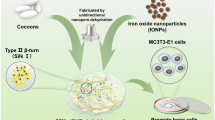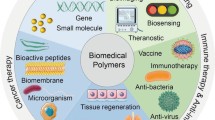Abstract
The response of extracellular matrix (ECM) to dynamic cell signals is of great significance for the regulation of cell behavior. In the present study, we prepared a type of matrix metalloproteinase (MMP)-sensitive degradable hydrogels (MSDHs) via the catalyst-free o-phthalaldehyde (OPA)/amine cross-linking reaction between o-phthalaldehyde-grafted four-arm poly(ethylene glycol) (4aPEG-OPA) and an MMP-sensitive degradable peptide. The gelation rates and storage moduli of MSDHs and the MMP-insensitive hydrogels (MIHs) based on an MMP-insensitive scramble peptide were comparable and dependent on the concentrations of precursor polymers. MSDHs were degradable while MIHs were stable in the presence of proteinase in vitro. The degradation of MSDHs was obviously faster than that of MIHs after subcutaneous injection into rats. In addition, both types of poly(ethylene glycol)/peptide hydrogels displayed excellent cytocompatibility in vitro, and showed good histocompatibility in vivo in the subcutaneous layer of rats. Furthermore, the proliferation of several MMP-expressing cell lines including MDA-MB-231 cells within MSDHs was obviously faster than that in MIHs, indicating the influence of metabolism-mediated scaffold degradation on the cell proliferation. This study provides a new biocompatible and biodegradable 3D cell culture interactive platform for regulation of cell behavior.
Similar content being viewed by others
References
Frantz C, Stewart K M, Weaver V M. The extracellular matrix at a glance. J Cell Sci, 2010, 123: 4195–4200
Mouw J K, Ou G, Weaver V M. Extracellular matrix assembly: A multiscale deconstruction. Nat Rev Mol Cell Biol, 2014, 15: 771–785
Walker C, Mojares E, Del Río Hernández A. Role of extracellular matrix in development and cancer progression. IJMS, 2018, 19: 3028
Nicolas J, Magli S, Rabbachin L, et al. 3D extracellular matrix mimics: Fundamental concepts and role of materials chemistry to influence stem cell fate. Biomacromolecules, 2020, 21: 1968–1994
Hussey G S, Dziki J L, Badylak S F. Extracellular matrix-based materials for regenerative medicine. Nat Rev Mater, 2018, 3: 159–173
Li W, Yan Z, Ren J, et al. Manipulating cell fate: Dynamic control of cell behaviors on functional platforms. Chem Soc Rev, 2018, 47: 8639–8684
Niklason L E. Understanding the extracellular matrix to enhance stem cell-based tissue regeneration. Cell Stem Cell, 2018, 22: 302–305
Tam R Y, Smith L J, Shoichet M S. Engineering cellular microenvironments with photo- and enzymatically responsive hydrogels: Toward biomimetic 3D cell culture models. Acc Chem Res, 2017, 50: 703–713
Rosales A M, Anseth K S. The design of reversible hydrogels to capture extracellular matrix dynamics. Nat Rev Mater, 2016, 1: 15012
Chaudhuri O, Gu L, Klumpers D, et al. Hydrogels with tunable stress relaxation regulate stem cell fate and activity. Nat Mater, 2016, 15: 326–334
Wang H B, Li H F, Wu Y H, et al. A high strength, anti-fouling, self-healable, and thermoplastic supramolecular polymer hydrogel with low fibrotic response. Sci China Tech Sci, 2019, 62: 569–577
Rong Y, Zhang Z, He C, et al. Bioactive polypeptide hydrogels modified with RGD and N-cadherin mimetic peptide promote chondrogenic differentiation of bone marrow mesenchymal stem cells. Sci China Chem, 2020, 63: 1100–1111
Shi S, Yu S J, Li G, et al. Biocompatible in situ-forming glycopolypeptide hydrogels. Sci China Tech Sci, 2020, 63: 992–1004
Zhu J. Bioactive modification of poly(ethylene glycol) hydrogels for tissue engineering. Biomaterials, 2010, 31: 4639–4656
Yu L, Ding J. Injectable hydrogels as unique biomedical materials. Chem Soc Rev, 2008, 37: 1473–1481
Ko D Y, Shinde U P, Yeon B, et al. Recent progress of in situ formed gels for biomedical applications. Prog Polym Sci, 2013, 38: 672–701
Zhang Z, He C, Rong Y, et al. A fast and versatile cross-linking strategy via o-phthalaldehyde condensation for mechanically strengthened and functional hydrogels. Natl Sci Rev, 2020, doi: https://doi.org/10.1093/nsr/nwaa128
Do Minh T, Johnson A L, Jones J E, et al. Reactions of phthalaldehyde with ammonia and amines. J Org Chem, 1977, 42: 4217–4221
Ma Y, Lv Z, Li T, et al. Design and synthesis of ortho-phthalaldehyde phosphoramidite for single-step, rapid, efficient and chemoselective coupling of DNA with proteins under physiological conditions. Chem Commun, 2018, 54: 9434–9437
Kharkar P M, Kiick K L, Kloxin A M. Designing degradable hydrogels for orthogonal control of cell microenvironments. Chem Soc Rev, 2013, 42: 7335–7372
Koetting M C, Peters J T, Steichen S D, et al. Stimulus-responsive hydrogels: Theory, modern advances, and applications. Mater Sci Eng-R-Rep, 2015, 93: 1–49
Liu S, Cao H, Guo R, et al. Effects of the proportion of two different cross-linkers on the material and biological properties of enzymatically degradable PEG hydrogels. Polym Degradation Stability, 2020, 172: 109067
Ma S Q, Zhang Y P, Wang M, et al. Recent progress in 4D printing of stimuli-responsive polymeric materials. Sci China Tech Sci, 2020, 63: 532–544
Visse R, Nagase H. Matrix metalloproteinases and tissue inhibitors of metalloproteinases. Circ Res, 2003, 92: 827–839
Kessenbrock K, Plaks V, Werb Z. Matrix metalloproteinases: Regulators of the tumor microenvironment. Cell, 2010, 141: 52–67
Quintero-Fabián S, Arreola R, Becerril-Villanueva E, et al. Role of matrix metalloproteinases in angiogenesis and cancer. Front Oncol, 2019, 9: 1370
Lu Y, Aimetti A A, Langer R, et al. Bioresponsive materials. Nat Rev Mater, 2017, 2: 16075
Huebsch N. Translational mechanobiology: Designing synthetic hydrogel matrices for improved in vitro models and cell-based therapies. Acta Biomater, 2019, 94: 97–111
Leight J L, Tokuda E Y, Jones C E, et al. Multifunctional bioscaffolds for 3D culture of melanoma cells reveal increased MMP activity and migration with BRAF kinase inhibition. Proc Natl Acad Sci USA, 2015, 112: 5366–5371
Fonseca K B, Maia F R, Cruz F A, et al. Enzymatic, physicochemical and biological properties of MMP-sensitive alginate hydrogels. Soft Matter, 2013, 9: 3283–3292
Fonseca K B, Bidarra S J, Oliveira M J, et al. Molecularly designed alginate hydrogels susceptible to local proteolysis as three-dimensional cellular microenvironments. Acta Biomater, 2011, 7: 1674–1682
Schmidt P, Zhou L, Tishinov K, et al. Dialdehydes lead to exceptionally fast bioconjugations at neutral pH by virtue of a cyclic intermediate. Angew Chem Int Ed, 2014, 53: 10928–10931
Even-Ram S, Artym V, Yamada K M. Matrix control of stem cell fate. Cell, 2006, 126: 645–647
Chau Y, Tan F E, Langer R. Synthesis and characterization of dextranpeptide-methotrexate conjugates for tumor targeting via mediation by matrix metalloproteinase II and matrix metalloproteinase IX. Bioconjugate Chem, 2004, 15: 931–941
Partridge C A, Phillips P G, Niedbala M J, et al. Localization and activation of type IV collagenase/gelatinase at endothelial focal contacts. Am J Physiol-Lung Cellular Mol Physiol, 1997, 272: L813–L822
Tung C L, Wong C T T, Fung E Y M, et al. Traceless and chemoselective amine bioconjugation via phthalimidine formation in native protein modification. Org Lett, 2016, 18: 2600–2603
Cheng Y, He C, Xiao C, et al. Versatile biofunctionalization of polypeptide-based thermosensitive hydrogels via click chemistry. Biomacromolecules, 2013, 14: 468–475
Ren K, He C, Xiao C, et al. Injectable glycopolypeptide hydrogels as biomimetic scaffolds for cartilage tissue engineering. Biomaterials, 2015, 51: 238–249
Brown S, Bernardo M M, Li Z H, et al. Potent and selective mechanism-based inhibition of gelatinases. J Am Chem Soc, 2000, 122: 6799–6800
Hannocks M J, Zhang X, Gerwien H, et al. The gelatinases, MMP-2 and MMP-9, as fine tuners of neuroinflammatory processes. Matrix Biol, 2019, 75–76: 102–113
Author information
Authors and Affiliations
Corresponding author
Additional information
This work was supported by the National Natural Science Foundation of China (Grant Nos. 51973218, 51622307, 21574127, 51520105004), and the Youth Innovation Promotion Association CAS.
Supporting Information
11431_2020_1731_MOESM1_ESM.doc
Matrix metalloproteinase-sensitive poly(ethylene glycol)/peptide hydrogels as an interactive platform conducive to cell proliferation during 3D cell culture
Rights and permissions
About this article
Cite this article
Rong, Y., Zhang, Z., He, C. et al. Matrix metalloproteinase-sensitive poly(ethylene glycol)/peptide hydrogels as an interactive platform conducive to cell proliferation during 3D cell culture. Sci. China Technol. Sci. 64, 1285–1294 (2021). https://doi.org/10.1007/s11431-020-1731-8
Received:
Accepted:
Published:
Issue Date:
DOI: https://doi.org/10.1007/s11431-020-1731-8




